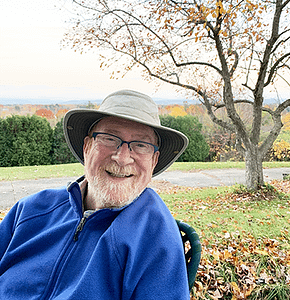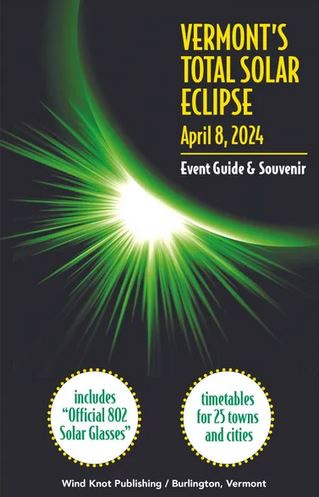Peter Shea ’69 publishes souvenir eclipse-viewing guide for April 2024
Vermont will be among direct-path prime locations for witnessing rare event next year, and veteran author says it is never too soon to think and plan ahead

Peter Shea ’69
Peter Shea ’69 is author of a new “event guide and souvenir” for the total solar eclipse that will occur in view directly across Vermont about a year from now on April 8, 2024.
“It already sold out the first small printing of 1,500 copies,” Shea said.
Published by Shea’s Wind Knot Publishing in Burlington, this small 12-page publication, priced at $12.95 and available for order online or in many Vermont bookstores, gift shops and other outlets, includes “Official 802 Solar Glasses” for viewing the eclipse safely. “These glasses are safety rated — ISO Certification: 12312-2,” he said of the bonus item within the guide.
Shea’s eclipse guide already has garnered publicity including a story on WCAX, the Burlington-area CBS affiliate, and an item in Seven Days, the Burlington weekly newspaper and website. The author-publisher previously has created, written and published numerous books on Vermont, including road atlases, maps, fishing guides, geography for middle schools, cross-country skiing and hiking.
His published reference “Access America: An Atlas and Guide to the National Parks for Visitors with Disabilities,” won recognition as a “Best Reference” by the American Library Association and was awarded American Express’s first “Mark of Innovation.” Shea founded Wind Knot Publishing in 2015 and has published several books on trout fishing under this imprint.
The eclipse souvenir guide starts with a mostly blank page with lines to allow “commemoration & comment” for eclipse observers. It goes on to offer interesting context about solar eclipses through human history, a simple scientific explanation describing “What is an eclipse?”, an account of the last total eclipse in Vermont on August 31, 1932, and a detailed preview of the April 8, 2024 eclipse in terms of its path and how to safely view it.
The guide also explains the Vermont timetable for viewing that makes up one page. Across Vermont, the eclipse will start depending on location between 2:14 p.m. and 2:14:25 and end at 4:38:30 in the Northeast Kingdom, the timetable shows. Shea’s guide wraps up with “some eclipse phenomena to observe” so viewers know what to look for more precisely, and QR codes for relevant Vermont or national resources regarding the eclipse.
The Bigger Picture
The Monday, April 8, 2024, total solar eclipse will cross North America, passing over Mexico, the United States, and Canada. The total solar eclipse will begin over the South Pacific Ocean. Weather permitting, the first location in continental North America that will experience totality is Mexico’s Pacific coast at around 11:07 a.m. PDT.
The path of the eclipse continues from Mexico, entering the United States in Texas, and traveling through Oklahoma, Arkansas, Missouri, Illinois, Kentucky, Indiana, Ohio, Pennsylvania, New York, Vermont, New Hampshire, and Maine. The eclipse will enter Canada in Southern Ontario, and continue through Quebec, New Brunswick, Prince Edward Island, and Cape Breton. The eclipse will exit continental North America on the Atlantic coast of Newfoundland, Canada, at 5:16 p.m. NDT.
Saint Michael’s connections
Shea, a Saint Michael’s “Golden Knight” (alumni 50 years or more out), said since retiring, he has published “about seven books,” mostly about his passion for trout fishing. In fact, he said, he was trout fishing during the most recent partial solar eclipse visible in Vermont six years ago, which made him resolve to create this guide for the next one as the rare event drew nearer.
“Saint Michael’s College did wonders for me,” Shea said, explaining that he had a variety of different interesting careers since his 1969 graduation. “You name it, from making feathered jewelry to bartending, just all kinds of stuff,” said Shea, a man of broad interests who even today works as a standardized patient at the UVM Medical School as something else interesting and useful to do.
Eventually after St. Mike’s and early jobs he went back to college at the University of Vermont, studying geography at the graduate-school level, though he did not finish his thesis. Still, it prepared him well to open a business – Northern Cartographic, which created road maps and atlases of Vermont. After 13 years in publishing, Shea moved on to Vermont Public Television where he became director of Corporate Support in a 20-plus-year career.

John O’Meara
Shea’s Wind Knot Publishers publicity for the new eclipse guide includes a quote from John O’Meara, deputy director and chief scientist at Hawaii’s Keck Observatory. O’Meara, a former Saint Michael’s physics professor, states, “It’s wonderful for a rare astronomical event to be something we can all enjoy together as a community and pass on the experience to the next generation. Vermont is right in the path of totality for the eclipse, and should see quite a show. I hope you can experience this event with your friends and family in 2024!”
Shea, a native of Holyoke, MA, and a sociology major as a Saint Michael’s undergraduate, said when he worked at Vermont Public Television at Fort Ethan Allen, “I sometimes thought of the nearby former cavalry building 500 feet away [now Elley-Long Music Center] where we did our comprehensive exams in my student days.”
“I think the education I got at Saint Michael’s served me well,” he said. “When I went back to graduate school, I was nervous at first, but very soon I was thinking, ‘whoa, did I get a good education!’ I knew how to research, how to write, so it was pretty easy to slip back in, given the tools that Saint Michael’s gave me.”






